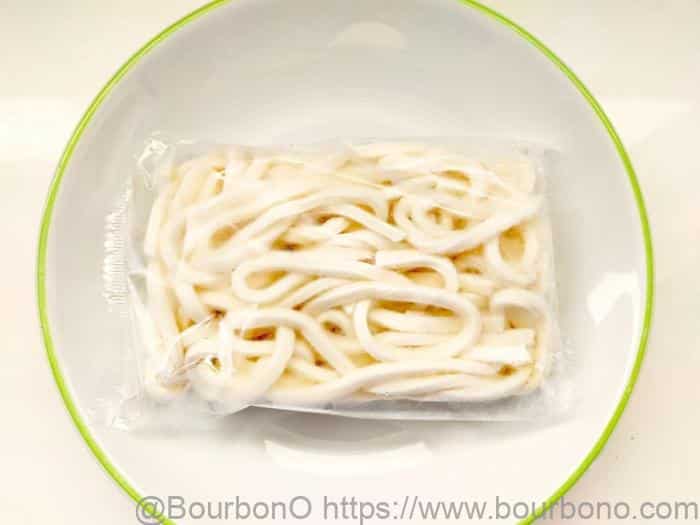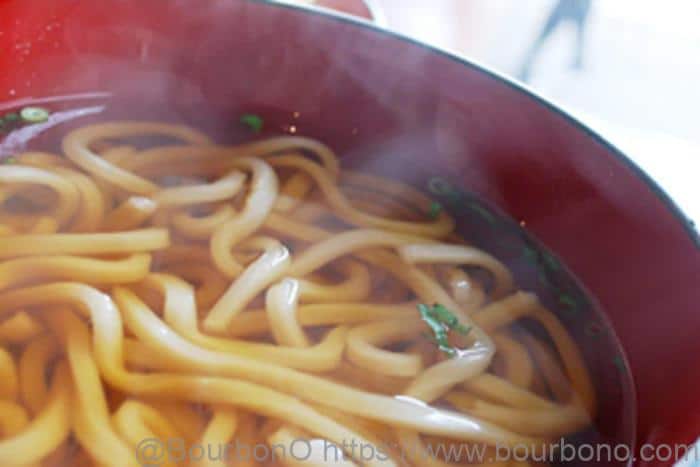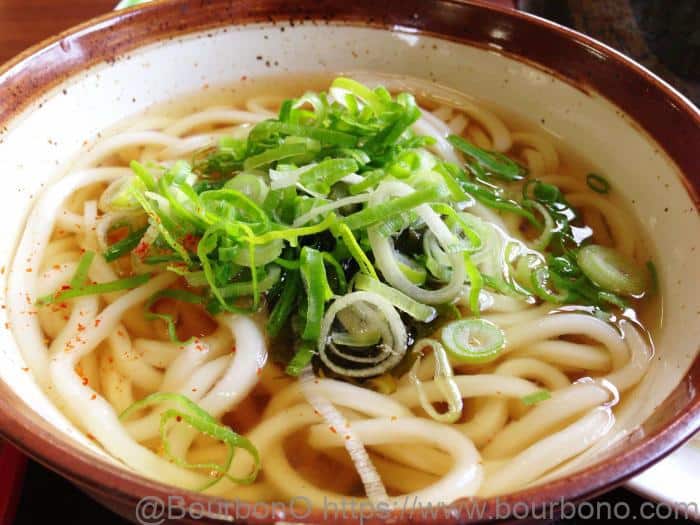How to cook frozen Udon noodles is something you should know to make a tasty dish out of this type of noodles. Frozen udon is definitely one of the kitchen staples as it’s easy to keep in stock. However, the key to a perfect bowl of udon noodles lies in the thawing technique. In fact, if you make a mistake when cooking frozen udon, it’s deliciousness might be affected quite significantly. Don’t be too worried, as Bourbon O will show you the right way to cook your udon noodles!
Origin of Udon noodles
Since ancient times, Udon noodles have been chosen by the Japanese as a fast food. For centuries, the country’s love for Udon noodles has remained intact. Udon noodles were introduced to Japan in the 8th century, the technique of making Udon noodles comes from neighboring China. During country trips to mainland China, messengers from the Nara court brought this technique back to Japan.
Experiencing a series of historical events, Japanese udon noodles have many typical flavors of many different regions. Udon noodle soup in the Kansai region is light and frugal, cooked from seaweed in a very short time, and then seasoned with light soy sauce. The soup broth of Kanto Udon noodles is quite thick, because it is cooked with a lot of fish and uses a strong soy sauce for seasoning. The difference in the color of the noodle soup can be seen clearly: Kansai soup is lighter and clearer in color, while Kanto soup is darker in color.
Depending on the weather, udon noodles have different processing methods. Cold Udon noodles are made with delicious meat broth, often served on hot summer afternoons to cool off, served with vegetables such as cabbage and cucumber. On winter days, the broth is usually hotter, with more protein and nutrients, providing many nutrients for the body and helping to keep people warm.
How to cook frozen Udon noodles
Choosing the Right Pot
The first step in preparing frozen udon noodles is to select the right pot. The pot should be large enough to accommodate the noodles without overcrowding them, which can cause them to clump together and cook unevenly. A pot with a lid is also ideal because it helps to retain heat and bring the water to a boil more quickly.
Measuring the Amount of Water
The ratio of water to noodles is important when cooking frozen udon noodles. To ensure that the noodles cook properly, you need to calculate the right amount of water for the pot. A good rule of thumb is to use about 6 cups of water for every 8 ounces of udon noodles. This will provide enough water to fully submerge the noodles and ensure that they cook evenly.
Bringing Water to a Boil
Once you have the right pot and amount of water, the next step is to bring the water to a rolling boil. It’s important to wait until the water is fully boiling before adding the noodles. If the water is not hot enough, the noodles may cook unevenly and become mushy. Adding salt to the water is optional, but it can help to enhance the flavor of the noodles.
Overall, preparing to cook frozen udon noodles involves selecting the right pot, measuring the correct amount of water, and bringing the water to a boil before adding the noodles. Following these steps will ensure that the noodles cook properly and have the right texture and flavor.
Microwave
Step 1: Take the frozen udon out of the freezer and place it directly in a microwave-safe bowl. Do not defrost the noodles.
Step 2: Add spices according to your preference (if you make noodle soup). Pour in the bowl enough water to cover the noodle.
Step 3: Heat on high until al dente (for about 4 to 5 minutes). Remember the microwave oven’s wattage varies, so it’s advisable to keep an eye on the noodles while they’re heating. If you make fried noodles, discard the excess water and add spices according to your preference.

Stir-fry
Step 1: In a large skillet or wok, add 1 tbsp of oil and heat up. Add desired veggies or meat and stir fry.
Step 2: Halfway through cooking time, add frozen udon noodles and 3/4 cup of water. Stir fry for about 3 minutes on medium-high heat. Add desired spices to taste.
Related article: How to cook pizza rolls without them exploding – Secret cooking tips
Stove Top
Step 1: To make noodle soup, first add water to a pan and bring the water to a boil.
Step 2: Pull the frozen udon out from the freezer and place it directly in the pan. Do not defrost the noodles.
Step 3: Cook over medium heat until al dente (for about 40 – 60 seconds).

How do you thaw frozen Udon noodles and make them “sticky”
This way of thawing udon noodles will give your udon chewy and fluffy texture. That’s why this method is especially recommended to satisfy your craves for cold udon.
Step 1: Unwrap the udon noodles and get it wet under running water.
Step 2: Place your wet frozen udon noodles on a heat-resistant dish. Use plastic wrap to cover the dish tightly and put it in the microwave. Heat at the recommended time for your udon noodle brand.
Step 3: In a colander, open the thawed noodles and wash them with running water thoroughly. Add ice to tighten the noodles.
Step 4: Drain the water and serve the udon noodles in a bowl. Add seasoning and all kinds of toppings you want, such as kamatama udon, bukkake, colander…
Article may interest you: FAQ: How long to cook pork tenderloin in oven at 375 degrees F?
Notes:
Time cooking: Both dried and fresh udon noodles can be cooked in salted boiling water until they become tender. Dried udon should take about 8 minutes and the fresh ones take approximately 3 minutes.

Toppings: There are a wide variety of ingredients that you can add to your udon noodles. If you’re a big fan of fried food, we suggest adding some tempura such as nasu, ebi, kabocha, okra, green beans… However, just simply add some boiled eggs, cooked chicken/pork/beef and some veggies and your bowl of udon noodles is ready to be served!
Preservation: The cooked udon noodles can be refrigerated for a couple of days. However, it’s tastier if you freeze the fresh udon noodles right away. Frozen noodles come in segmented blocks. That’s why you can make as many servings as you want out of them and freeze the rest. According to the FDA, udon noodles can last for up to 7 days after opening the udon pack, assuming a stable temperature of 5 degrees C or 40 degrees F. Freshly prepared noodles stored in the freezer can last for up to 1 month.
Can you fry frozen udon?
Technically, you can fry frozen udon noodles, but it may not yield the best results. Frozen udon noodles are typically designed to be cooked in boiling water and then served as part of a soup or stir-fry dish. When you fry frozen udon noodles, they may not cook evenly or maintain their texture, and they may become too soft or mushy.
If you want to try frying udon noodles, it’s generally recommended to use fresh or refrigerated udon noodles instead of frozen ones. Fresh or refrigerated udon noodles have a higher moisture content and a more elastic texture, which makes them better suited for stir-frying. You can cook the fresh or refrigerated udon noodles in boiling water for a few minutes, drain them, and then rinse them with cold water before using them in a stir-fry dish.
Overall, while you can technically fry frozen udon noodles, it’s not the most recommended way to prepare them. It’s best to use fresh or refrigerated udon noodles if you want to fry them in a stir-fry or other dish.
Is frozen udon already cooked?
Technically, you can fry frozen udon noodles, but it may not yield the best results. Frozen udon noodles are typically designed to be cooked in boiling water and then served as part of a soup or stir-fry dish. When you fry frozen udon noodles, they may not cook evenly or maintain their texture, and they may become too soft or mushy.
If you want to try frying udon noodles, it’s generally recommended to use fresh or refrigerated udon noodles instead of frozen ones. Fresh or refrigerated udon noodles have a higher moisture content and a more elastic texture, which makes them better suited for stir-frying. You can cook the fresh or refrigerated udon noodles in boiling water for a few minutes, drain them, and then rinse them with cold water before using them in a stir-fry dish.
Overall, while you can technically fry frozen udon noodles, it’s not the most recommended way to prepare them. It’s best to use fresh or refrigerated udon noodles if you want to fry them in a stir-fry or other dish.
Do you need to cook frozen udon?
Yes, you need to cook frozen udon noodles before consuming them. Frozen udon noodles are typically raw and have not been precooked, so they need to be boiled in water or soup before eating. Cooking frozen udon noodles ensures that they are fully cooked, safe to eat, and have the desired texture and flavor.
When cooking frozen udon noodles, it’s important to follow the package instructions carefully to ensure that the noodles are cooked properly. The cooking time and water ratio may vary depending on the brand and type of frozen udon noodles, so it’s important to check the package instructions before cooking. In general, frozen udon noodles can be cooked by boiling them in water for a few minutes until they are tender but still slightly firm.
Overall, it’s necessary to cook frozen udon noodles before consuming them, as they are typically raw and need to be fully cooked to be safe and enjoyable to eat.
Why are my udon noodles soggy?
There could be several reasons why your udon noodles are turning out soggy:
- Overcooking: One of the most common reasons for soggy udon noodles is overcooking. If you boil the noodles for too long, they will become soft and mushy.
- Using too much water: If you use too much water when cooking your udon noodles, the excess water can make the noodles soggy. It’s important to use the correct amount of water for the amount of noodles you are cooking.
- Not rinsing the noodles properly: After cooking the udon noodles, it’s important to rinse them with cold water to remove excess starch and prevent them from sticking together. If you don’t rinse the noodles properly, they may become soggy.
- Not draining the noodles properly: It’s important to drain the udon noodles thoroughly after rinsing them. If you don’t drain them properly, excess water can make the noodles soggy.
- Using old or expired noodles: If your udon noodles are old or expired, they may become mushy or soggy when cooked.
To prevent soggy udon noodles, make sure to follow the package instructions carefully, use the correct amount of water, and avoid overcooking. Also, be sure to rinse and drain the noodles properly and use fresh noodles that have not expired.
Are udon noodles healthy?
Udon noodles can be a healthy part of a balanced diet when consumed in moderation and prepared in a healthy way. Here are some of the potential health benefits of udon noodles:
- Low in Fat and Calories: Udon noodles are low in fat and calories, making them a good choice for those who are watching their weight or trying to maintain a healthy diet.
- Good Source of Carbohydrates: Udon noodles are a good source of carbohydrates, which provide energy for the body. They are also low in sugar, which can help prevent blood sugar spikes and crashes.
- Rich in Nutrients: Udon noodles contain a range of essential nutrients, including protein, fiber, and various vitamins and minerals. For example, udon noodles made from whole wheat flour may be higher in fiber and B vitamins than those made from white flour.
- Gluten-Free Options: Some brands of udon noodles are made from gluten-free ingredients such as rice flour or buckwheat flour, making them a good option for those who have celiac disease or gluten sensitivity.
However, it’s important to note that udon noodles are typically made from refined flour and may contain high amounts of sodium if they are served in a soup or stir-fry dish. It’s important to consume udon noodles in moderation and to choose healthy preparation methods such as cooking them in a broth with vegetables or stir-frying them with lean protein and vegetables.
Is frozen or dry udon better?
Whether frozen or dry udon noodles are better depends on personal preference and the intended use. Here are some factors to consider:
- Texture: Frozen udon noodles tend to have a softer, chewier texture compared to dry udon noodles, which can be more firm and springy. Some people prefer the softer texture of frozen udon noodles, while others prefer the firmer texture of dry udon noodles.
- Convenience: Frozen udon noodles are more convenient because they can be cooked directly from frozen without needing to be thawed first, which can save time. Dry udon noodles, on the other hand, need to be boiled in water for a few minutes before they can be used.
- Availability: Frozen udon noodles may be easier to find in some regions, while dry udon noodles may be more common in other areas.
- Shelf Life: Dry udon noodles have a longer shelf life than frozen udon noodles, which can be an advantage if you don’t use udon noodles frequently.
- Price: The price of frozen and dry udon noodles can vary depending on the brand and location, but generally, dry udon noodles tend to be less expensive than frozen udon noodles.
Is udon healthier than ramen?
Comparing udon and ramen in terms of their health benefits, udon is generally considered to be a healthier option. Here are some reasons why:
- Lower in Sodium: Udon noodles typically contain less sodium than ramen noodles. Ramen noodles are often served in a salty broth, which can contribute to high sodium intake. Udon noodles are often served in a lighter broth or sauce, which may contain less sodium.
- Less Processed: Udon noodles are typically made from simpler, less processed ingredients such as wheat flour and water, whereas ramen noodles are often made with added fats, salts, and other ingredients to enhance their flavor and texture.
- Higher in Nutrients: Udon noodles can be a good source of protein, fiber, and other essential nutrients. Udon noodles made from whole wheat flour can be particularly high in fiber and B vitamins.
- Less Caloric: Udon noodles are typically lower in calories than ramen noodles. A serving of udon noodles may contain around 200-250 calories, whereas a serving of ramen noodles can contain 400-500 calories or more.
- Gluten-Free Options: Udon noodles can be made from gluten-free ingredients such as rice flour or buckwheat flour, making them a good option for those with celiac disease or gluten sensitivity. Ramen noodles, on the other hand, are typically made from wheat flour and are not gluten-free.
Is udon difficult to digest?
Udon noodles are generally not difficult to digest for most people. Udon noodles are made from wheat flour and water, and they are a good source of carbohydrates and fiber. The body breaks down carbohydrates into glucose, which is used for energy, and fiber helps to keep the digestive system healthy.
However, some people may experience digestive issues after consuming udon noodles, especially if they have gluten sensitivity or celiac disease. Gluten is a protein found in wheat, barley, and rye, and it can cause digestive discomfort in some people. If you have gluten sensitivity or celiac disease, it’s important to choose gluten-free udon noodles or other gluten-free alternatives.
Additionally, if udon noodles are not cooked properly, they may become gummy and difficult to digest. Overcooking the noodles or not rinsing them properly after cooking can lead to a sticky, heavy texture that may be harder to digest.
When using the correct cooking method, the texture of your udon noodles will be chewy and fluffy, which is the main characteristic that makes this type of noodles stand out from the rest. Hopefully with the cooking guide Bourbono just introduced above, you’ll know exactly how to cook frozen Udon noodles. Enjoy a hot bowl of Udon noodles with your favorite toppings!




